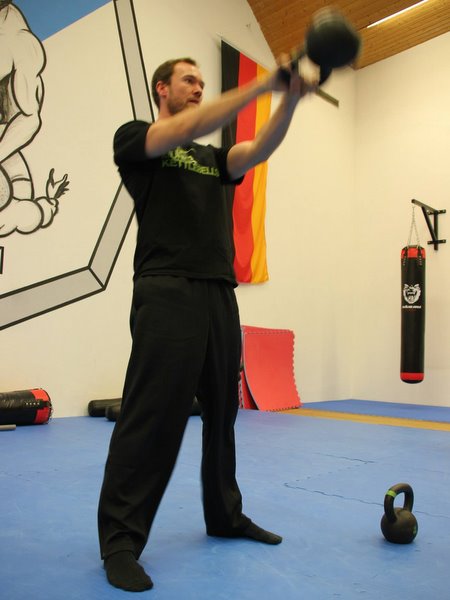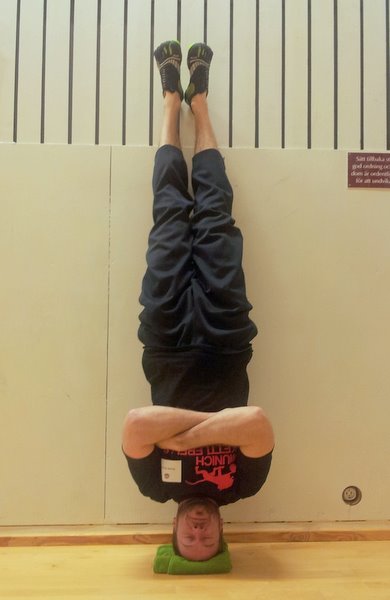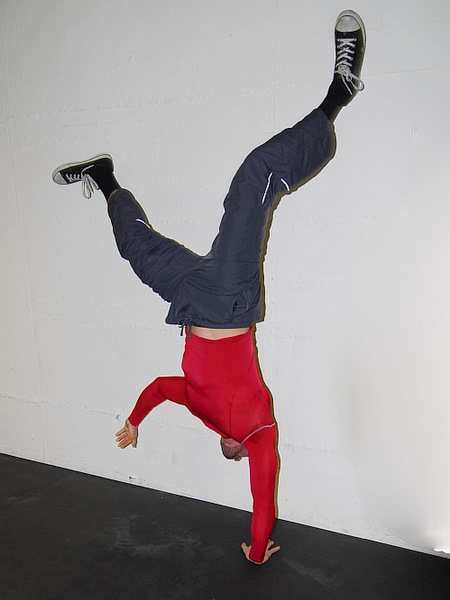Dragon Door: How were you first introduced to kettlebells?
Steven Graves: About 4-5 years ago, I read about kettlebells in an internet forum about weight training, nutrition and supplements here in Germany. Some of the guys on the forum have been successful trainers for over 20 years and wrote about their first kettlebell experiences. They were amazed at the intensity and efficiency of this kind of strength training. So, I thought it sounded very interesting. A few weeks later I´m sitting in my car when a van stops on my left side. On the side of the van is a huge logo with an old time strongman holding a
kettlebell, underneath is written "hardstyletraining".
I googled "hardstyletraining Munich," and just two weeks later, I was in a gym with Robert Rimoczi, Senior RKC for my first lesson in kettlebell training. This was the beginning of my kettlebell journey. I´m super happy to have seen that van four years ago!
Dragon Door: What results have you experienced from training with kettlebells?
 Steven Graves:
Steven Graves: I first started training with kettlebells out of curiosity. I thought I was quite strong and had fairly good endurance before I tried them. At my very humbling first kettlebell experience, I found out that I was wrong! At first, I "nailed" my first
FMS with a score of 13 points. But after 12 weeks of intense and profound kettlebell lessons with Mr. Robert Rimoczi, my score went up to 17 points. My overall fitness performance has rapidly improved since I started with kettlebells and peaked after 6-9 months of training. I realized the strength I gained through this kind of training is general and has helped me perform moves and feats that I´ve never or barely trained before—a solid handstand, L-sit hold for 15 seconds, rope climbing, etc. I think my body is now more powerful, explosive and stable than ever before. After 3 years of kettlebell training, I´m able to maintain my
strength and conditioning level with a minimum amount of workout time.
Dragon Door: How does your experience as a psychologist help when working with your fitness clients?
Steven Graves: I think my background as a psychologist helps me understand that the art of successfully working with clients involves much more than just properly demonstrating and instructing. You have to motivate people—big time! Your clients will only stick to the training protocol and get serious results if they are motivated. Fortunately, serious results create more motivation and so on...
The good thing about kettlebell training is amazing results happen within a short period of time. My clientele is quite diverse, but many began with very bad fundamental movement patterns. After they learn to properly perform get-ups, the patterns are quickly improved and the clients are happy.
Another useful skill I have as a psychologist and a personal trainer / fitness trainer, is the ability to adapt to the client's language patterns, style of speaking, learning speed, concentration span and sometimes even their way of thinking. For example it´s very interesting to work with people who have engineering or physics knowledge, because I can explain the biomechanical facts of the Hardstyle kettlebell swing differently—and sometimes I can learn new things from them, too. If you speak the language of the client, he or she will trust you more quickly and feel a common bond, which is also beneficial for the client-trainer relationship.
Dragon Door: How did you decide to attend the Progressive Calisthenics Certification Workshop in Sweden?
Steven Graves: Before I started with kettlebell training, I had been using weighted bodyweight exercises like pull-ups, chin-ups, push-ups and dips in my training protocol. I love to train with kettlebells, but felt like I was missing a good vertical pulling exercise for the upper body. For me, the pull-up seems to work better than just the negative phase of the kettlebell military press. Robert Rimoczi went to the very first
PCC Workshop in the US and told me he was amazed. I know that Robert is not a guy who is easily impressed. So, when he told me the PCC rocks, I knew it must be a very good system and certification. I also think
RKC kettlebell training and the PCC system work together perfectly. Long story short, I signed up for the PCC in Goteborg, Sweden. It was an awesome experience, especially because of the special vibe during the three days.
Dragon Door: What was the biggest thing you learned at the PCC?
 Steven Graves:
Steven Graves: First of all, the Dragon Door and PCC Community is simply awesome! I loved the atmosphere and camaraderie during the workshop! But, I also learned a lot of things which have helped me integrate more
bodyweight exercises into my clients' training. I already had some basic knowledge about bodyweight exercises, but the workshop opened up a whole universe of countless variations. I have to admit, before the PCC workshop I didn´t think about variations of bridging, headstands, handstands, levers, and
flags. I had been more focused on dynamic drills like push-ups, pull-ups, and squats while neglecting the world of static bodyweight exercises. But, like yin & yang, both are important. Now I can work on both for myself and with my clients.
Dragon Door: How have you been using the ideas from PCC with your clients?
Steven Graves: Back in Germany, my colleagues Moritz Rammensee, Robert Rimoczi, and I have integrated some PCC elements and progressions into our training protocol. We've included many
squatting variations, push-up and pull-up progressions. Sometimes we have skill training sessions for moves like front and back levers, headstands, handstands, and
bridging. It is very cool to mix these bodyweight exercises with the RKC Big Six. It think these two systems combine perfectly.
Dragon Door: Who do you usually train? Have you noticed any patterns with the people who are interested in trying kettlebells and bodyweight exercise?
Steven Graves: My clients range in age from 18-70 years old, but there is a classic bell curve distribution that peaks at around 30 years. Quite often, I have recognized some common characteristics when working with my clients—I often work with people who want "the biggest bang for the buck" and are looking for very efficient training.
They are also detail oriented and like to focus on proper technique. They usually want to know why we do a particular movement in a specific manner. Most of my clients don´t just want to work out, they want to get better, move better, and enhance their athletic abilities. Many of them don't want to go to regular gyms anymore, and like the ability to train whenever and wherever they want.
Dragon Door: Earlier you mentioned how well the RKC and PCC movements and systems combine. Do you have a specific sequence or combination that you like to use with your clients or yourself?
Steven Graves: One of my favorite workout routines combines kettlebell swing or snatch rep ladders with front squat and push up rep ladders. When I'm training with tough people, we'll add
pull-up rep ladders too. It's similar to a "sissy test" but with three or four exercises instead of two. This workout has lower body push & pull movements combined with upper body push & pull movements—and it´s a smoker!
In general, I feel like there is a gap in kettlebell training concerning upper body push & pull movement patterns, but push-ups and pull-ups fill this gap perfectly.
Another important factor to consider when combining these two trainings systems are the open chain vs. closed chain exercise approaches. I think that trying to stabilize ourselves while swinging a kettlebell around our body´s center of gravity is a different task for the nervous system and neuromuscular activation than perform a pull-up or a front lever on a fixed bar. Again, it´s a little bit like balancing yin & yang—manipulation and adaptation. On one hand, I manipulate and hopefully master the kettlebell, on the other, my body adjusts to perform certain moves on unmovable objects like the ground or a bar. I think both training situations are very important and represent two sides of athleticism.
Dragon Door: What are your favorite kettlebell and bodyweight movements?
Steven Graves: My favorite kettlebell movement is the Turkish
get-up because it is like the fountain of youth for my older clients. When I do the TGU more often in my own training, I can feel my joints improving as if they were getting some kind of lube change! Also, the strength and skills from the get-up tremendously transfers over to many other exercises and movements.
In addition, the TGU is a self-correcting exercise. If a client understands the basic concepts and movement steps, he or she can improve while training alone. When starting with a new client, I usually prescribe a certain number of get-ups between our training sessions, and soon notice that the client gets stronger and more stable each session.
My favorite bodyweight move is the
front lever because I can't perform one yet, but really want to nail this move in 2014. It looks really cool, like defying gravity! Coolness aside, I think this move requires brutal strength in the lats and the ability to create extreme full body tension. These two things are very handy while performing all kinds of powerful movements.
Dragon Door: What is your next big goal?
 Steven Graves:
Steven Graves: I have different goals in different areas. Besides world domination, one big goal is to pass the Munich, Germany
RKC II in September 2014. Another goal I have with my colleague Moritz Rammensee is something we started called "Project Backflip 2014"—I hope this goal doesn´t interfere with the RKC II.
I also have some specific training goals such as a solid get-up with
48kg, a solid
40kg military press, and solid pistol squat for reps on both sides. I'd also like to be able to hold a front lever for at least 1 second. That's a lot to accomplish within 2014. It would also be awesome to get 1,500 likes on my Munich Kettlebells Facebook page in 2014 too!
In my fitness business, I have two main projects starting in 2014: Fitness Hoch 3 and the KRABA project. Just a few weeks ago, my kettlebell bro Sebastian Müller and I started a joint venture called Fitness Hoch 3 which means fitness³. The purpose of this project is to spread the word about our three training systems—RKC Kettlebell,
Primal Move, and PCC. Starting on February 22nd in Hamburg, we're going on a road tour around Germany. We hope make this a fun and cool way to teach more people about our training. Unfortunately, these great training approaches are nearly unknown here in good old Germany. But, we´re going on a mission to change that!
We´re offering three different three hour entry level seminars—one for each training system. Our Enter the Kettlebell seminar includes an introduction to the swing and Turkish get-up. Our Enter Primal Move seminar provides an overview of the movements and training approach. And our Progressive Calisthenics beginner seminar includes an introduction to the three basic, no-equipment needed exercise families of the
push-up, squat and bridge.
Our seminars are for beginning exercisers and fitness trainers who want an overview and introduction to these training systems. As we all know, it all looks simple and easy but each approach goes extremely deep into the very fundamentals of human movement. These seminars are meant to infect interested people with the kettlebell virus, the Primal Move fever and the PCC obsession!
The KRABA project launches on March 1st, 2014 in Munich. Moritz Rammensee, Robert Rimoczi and I have teamed up again to start a gym for real functional training with real results. And again RKC Kettlebell Training, Primal Move and PCC are the key ingredients of our training concept. Our location is very cool and we can´t wait to start our training there.